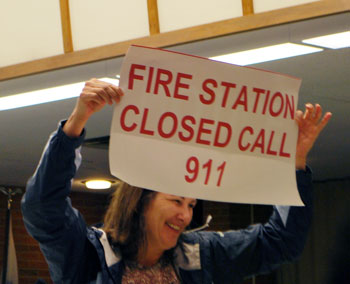There appears to be a water main break on Carpenter near Washtenaw. Construction zone by Palm Palace. AAPD says township is on it.
Stories indexed with the term ‘water main break’
Ann Arbor Acts on Core Equipment
Items related to equipment essential for core services have received approval by the Ann Arbor city council. That equipment includes a combination sewer truck, a hydraulic excavator, a garbage truck, two vans, a wood chipper, and a firefighter training unit. Votes on the equipment came at the council’s Feb. 18, 2014 meeting.
Two pieces of equipment authorized for purchase by the council are used in the repair of water main breaks, which have increased in frequency in recent weeks as the ground moves due to deeper and deeper penetration of frost.
Here’s a sampling of recent water main breaks – from alerts the city of Ann Arbor has sent out:
- Jan. 15: West Madison between Fourth and Fifth
- Jan. 22: Devonshire between Washtenaw and … [Full Story]
Pontiac Trail & Barton
Pontiac Trail blocked (broken water main, presumably) just north of Barton, with expected traffic chaos thru the neighborhood.
Ann Arbor Reports South Industrial Sewer Overflow
The city of Ann Arbor has announced that a sanitary sewer overflow took place on Jan. 28, 2014. According to a press release on the city’s website, the overflow was caused by the break of a 16-inch water main on South Industrial Highway, which caused a nearby sanitary sewer line to break.
Untreated water from the broken sanitary sewer line flowed up to the street via manholes, according to the press release. The untreated water then made its way into the city’s stormwater system, to Malletts Creek and, ultimately, to the Huron River. A report has been made to Michigan Dept. of Environmental Quality about the incident, according to the city.
In a conversation with The Chronicle last week, public services area … [Full Story]
Red Oak & Mixtwood
City crews labor into the night at a water main break, one of three in the city right now, according to one of the workers. [photo]
E. Stadium & Washtenaw
Water is flooding one lane of traffic along East Stadium, making exit from Trader Joe’s difficult. Looks like a water main break, but no one on site as of 3 p.m. [photo, looking west on East Stadium]
Manchester & Needham
Ann Arbor Budget Process Starts Up
A short meeting of the Ann Arbor city council’s budget committee – just before the full council’s Jan. 22 session – resulted in a consensus on an approach to budget planning for the next two-year cycle.

The Ann Arbor city council is beginning a budget planning process that should culminate in a council vote to adopt a fiscal year 2014 budget at its second meeting in May, which falls this year on May 20, 2013.
City administrator Steve Powers and chief financial officer Tom Crawford sketched out three kinds of topics they could explore with the full council at work sessions through the spring: (1) funding for items in the capital improvements plan (CIP); (2) budget impact analysis, broken down by service unit; and (3) additional resources required to support the city council’s five priority areas, which were identified in a planning session late last year.
The top three priority areas are: (1) city budget and fiscal discipline; (2) public safety; and (3) infrastructure. Two additional areas were drawn from a raft of other possible issues as those to which the council wanted to devote time and energy over the next two years: (4) economic development; and (5) affordable housing.
Possible city council work session dates are the second and fourth Mondays of the month. Regular meetings fall on the first and third Mondays.
The city council will be adopting a final budget for fiscal year 2014 by its second meeting in May. FY 2014 starts on July 1, 2013. Although the council approves an annual budget for the next fiscal year, the city uses a two-year planning cycle. This year starts a new two-year cycle, the first complete one for city administrator Steve Powers, who started the job about a year and a half ago, in September of 2011.
During some back-and-forth with the budget committee about the staff’s ability to provide all the information to the council that the committee had been describing – within the timeframe of the budget season – Powers joked: “Tom and I aren’t rookies!” Powers was previously Marquette County administrator for 16 years. Crawford has served as Ann Arbor’s CFO for more than eight years.
The council’s five-member budget committee consists of: Sabra Briere (Ward 1), Jane Lumm (Ward 2), Christopher Taylor (Ward 3), Marcia Higgins (Ward 4) and Mike Anglin (Ward 5).
An interesting wrinkle that emerged during the budget committee’s discussion was the role to be played by the city council in shaping the capital improvements plan (CIP). In response to some interest expressed by committee members to amend the CIP, Powers encouraged them to think in terms of allocating funds (or not) for elements of the plan. That’s because the content of the CIP is the statutory responsibility of the planning commission, not of the city council. The city council’s role is to determine which projects should be funded, Powers explained. But it’s for the city planning commission to finalize the content of the CIP itself.
This report includes more on the Michigan Planning Enabling Act (Act 33 of 2008) and the city council’s recent history of amending the CIP. [Full Story]
How to Report Ann Arbor Sewer Backups
The city of Ann Arbor has issued a statement about its emergency reporting process for sanitary sewer backups and water main breaks, in light of recent rains. For basement flooding, call the 24-hour Water Utilities Customer Service Center at 734-794-6333 to report the issue. Maintenance requests can be filed online using the city’s Citizen Request System – in Step 2 (Service Request Type), choose “Sanitary Sewer Issues” or “Water System Issues.”
In some neighborhoods, the city has been issuing vouchers that can be used to cover cleanup costs related to flooded basements. More information about filing a claim with the city is available online.
Ann Arbor Council Delays Budget Vote
Ann Arbor city council meeting (May 16, 2011): Ann Arbor’s city charter requires that the city council amend and adopt a city budget by its second meeting in May. If it fails to act, by default the unamended budget proposed in April by the city administrator is adopted.

During public commentary, Sue Maguire addressed the council on the topic of proposed reductions to the fire department. (Photos by the writer.)
But Monday, at its second meeting in May this year, the city council did not act, choosing instead to recess and continue the meeting the following week, on May 23. The decision to delay was prompted by uncertainty about revenue from the public parking system. The Ann Arbor Downtown Development Authority and the city were poised to ratify a new agreement on parking revenue on May 2, but that agreement was put off when questions were raised about the DDA tax increment finance (TIF) capture. The DDA later called a special meeting on Friday, May 20 to address that issue.
Even though the council did not act on the budget, most of the evening’s discussion was dominated by budget talk, including extensive public commentary on the proposed cuts in the police and fire departments. The council also got a briefing from its chief of police and interim fire chief, Barnett Jones, who responded to an article published in AnnArbor.com about fire department response times, calling the calculations presented in the piece inaccurate.
In addition to putting off action on the FY 2012 budget, the council also tabled decisions on human services funding, funding for a water system study, and fee increases for next year.
However, the council did transact some business. It authorized an increase in taxicab fares in light of rising gas prices. The council also approved neighborhood stabilization funds for demolition of three houses on North Main Street to prepare the site for construction of the Near North affordable housing project. Two large vehicle purchases – a street sweeper and a sewer truck – that had been postponed from the previous meeting were authorized.
The council also revised its administrative policy on how the 2006 parks millage is to be spent. Funds outside the general fund can count as general fund money for the purpose of the policy, as long as those funds are not drawn from the parks millage. The council also gave initial approval to an ordinance on design guidelines for new buildings downtown. [Full Story]



